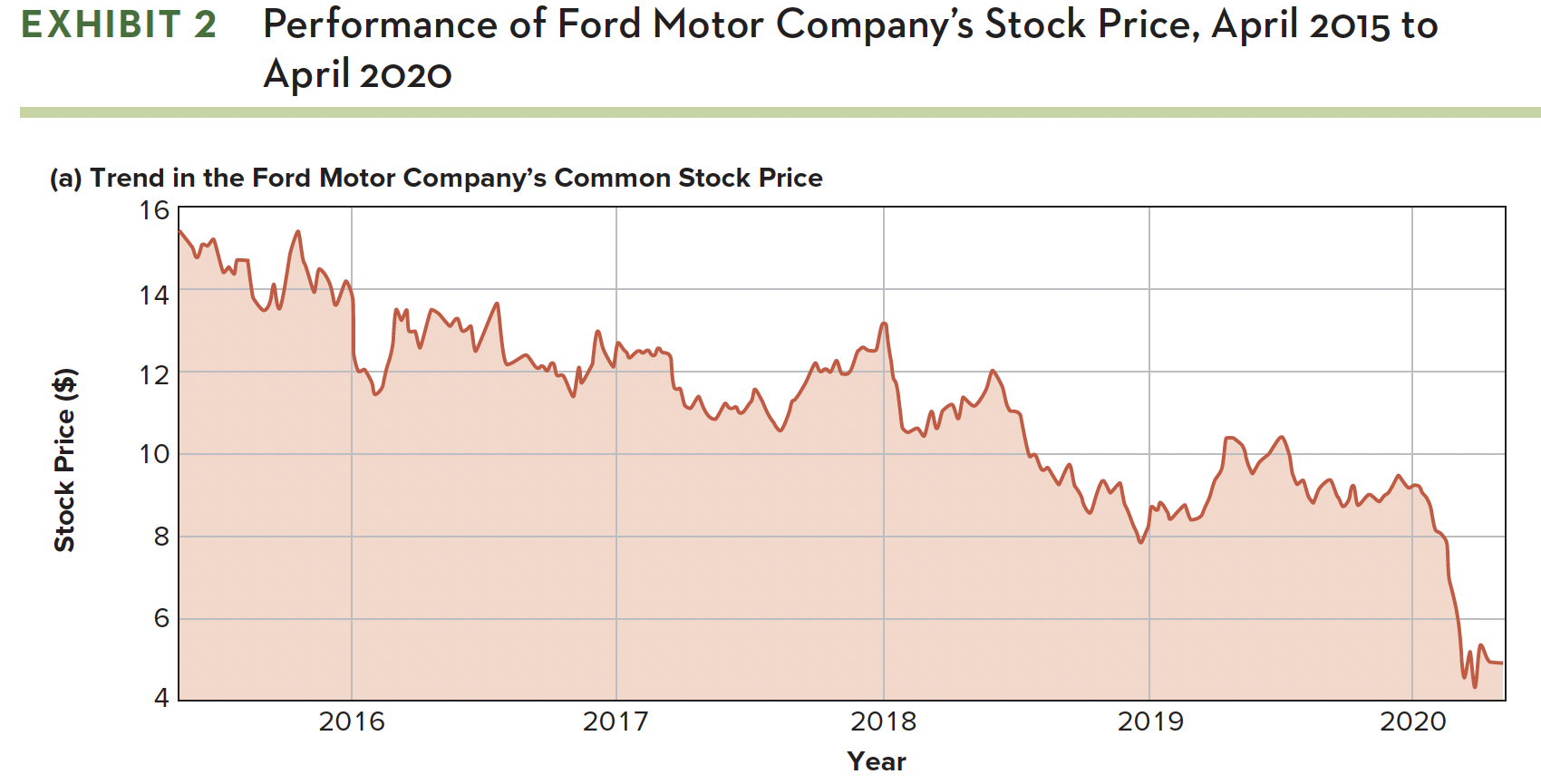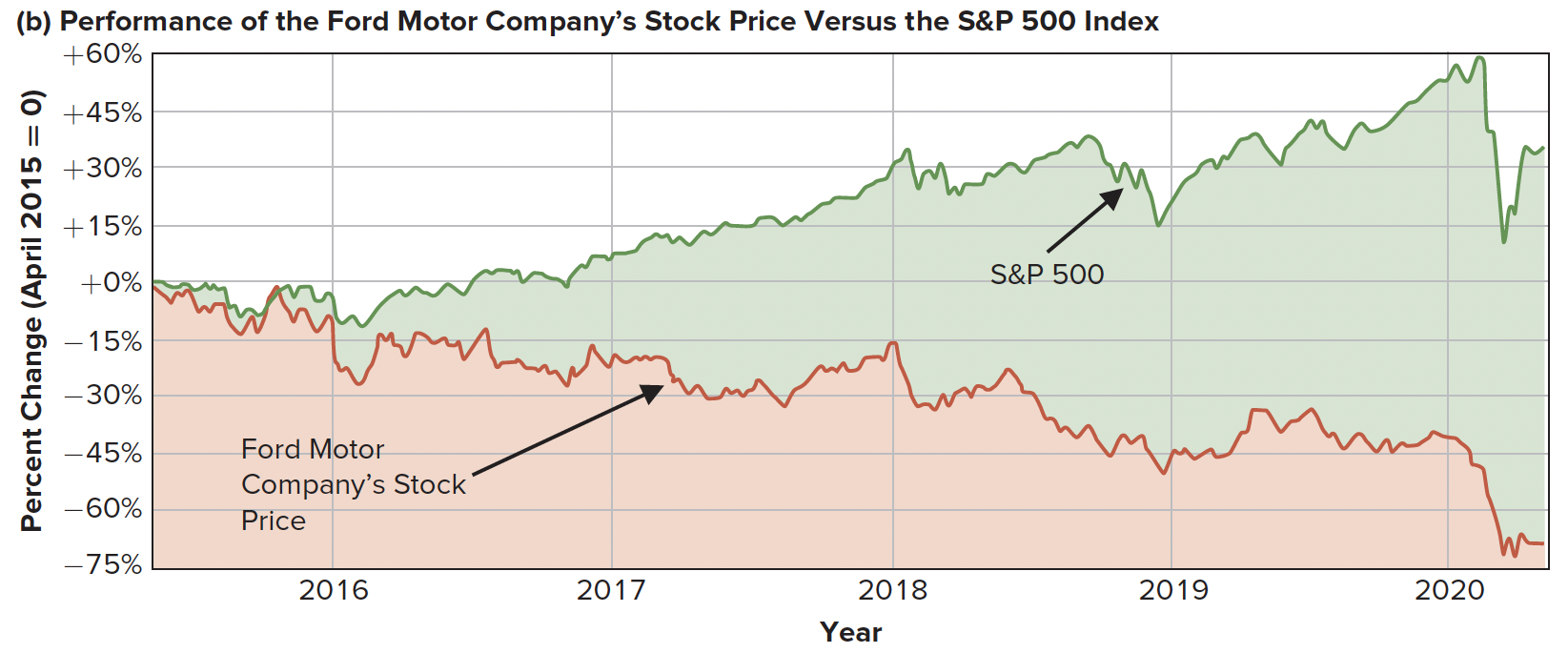Introduction
The Ford Motor Company is an American multinational corporation primarily designing, manufacturing, and selling cars and trucks. Despite its many challenges, such as economic recessions and shifting consumer preferences, the company has consistently demonstrated a remarkable ability to adapt and remain relevant. This is partly due to the strategic decisions made by its leadership team, who have continuously worked to stay ahead of the curve by developing new products, entering new markets, and forming strategic partnerships.
Discussion
Exhibit 2 presents the performance of Ford Motor Company’s stock price between 2016 and 2020. The company’s expected stock price trend shows a fluctuation between 10 and 16 dollars per stock, with the highest value in 2019. The performance of the Ford stock price compared to the S&P 500 Index reveals a decline in the stock price compared to the S&P 500. This suggests that the performance of the Ford Motor Company’s stock price could have been more substantial than the overall performance of the stock market represented by the S&P 500 Index.


In 2018, the U.S. retail sales volume of automobiles was segregated by product type, and the data was presented in Exhibit 6. The data shows that trucks were the largest segment, accounting for 45.6% of total retail sales. SUVs were the second largest segment, accounting for 34.9% of total sales, while cars were third, accounting for 19.4% of sales. Pickup trucks and sports utility vehicles accounted for 10.8% and 6.9% of sales, respectively, while the remaining 13.6% of sales was comprised of other product types.
The global automobile manufacturing industry provides a wide range of products and services, as shown in Exhibit 5. The production of cars accounts for 36.6% of global industry revenue, which is lower than its production volume due to the fact that cars sell at a lower price than SUVs and commercial vehicles. However, the car segment has been growing as consumers opt for more fuel-efficient vehicles.
In 2020, the Ford Motor Company Board faced some difficult decisions. The world’s developing economies primarily demand smaller automobiles, while the developed economies prefer larger crossovers, SUVs, and trucks. The company had already decided to discontinue the Ford Fusion, its most significant automobile, and the public was wondering if it would stop selling all cars except for the Mustang in the United States. There was also the question of what would happen if people began financing their vehicles at places other than Ford Credit.
Ford’s management team identified several difficulties the company encountered in 2020, including difficulties in getting new and existing products accepted in the market, challenges in selling more prominent, more profitable vehicles, heightened competition on pricing, changes in commodity prices, and variations in foreign exchange rates. Other factors considered were broader global economic conditions, product defects, and operational systems. Ford faced profitability difficulties in 2018 and 2019, but its financial arm, Ford Credit Company, posted its best results in 2019, with profits reaching $3 billion before taxes. This arm accounted for 50% of Ford’s profits, up from 15-20% in the past, and allowed the company to subsidize losses and maintain a high dividend yield.
In 2018, one of the key players in car exportation was the United States, even though car sales experienced a low share. To improve its strategic stance, the Ford Company focused on specific branding devices to appeal to customers. An example of this is the “Made in America” logo. Two years later, the company entered into a partnership with GE Healthcare to increase the production of a ventilator based on a design from GE Healthcare. GE had already licensed the ventilator design from Airon Corporation of Melbourne, Florida, and had been manufacturing cars close to their final destination to save on logistics costs.
The company’s decision-making process could have been more complex, as they had to consider various factors that could impact their bottom line. One such factor was the fluctuation in petroleum prices, which directly impacted the sales of large vehicles. While this seemed like a remote possibility, the events of 2020 made it a reality that they could no longer ignore. The United States, Russia, and the United Arab Emirates decided to limit their daily petroleum production in 2020. This decision impacted the global energy market and caused the price of petroleum to skyrocket overnight. The company realized that the once remote possibility of petroleum prices rising again was now a genuine concern.
The Ford Motor Company is a leading player in the global automobile industry and has faced several challenges over the years. The company responded to these challenges by focusing on specific branding devices and entering into partnerships with other companies to increase production. The corporation considered the possibility of petroleum prices rising again and the impact that would have on large vehicle sales. Despite these challenges, the company is expected to remain a major player in the industry and continue to be a significant player in shaping the future of the global automobile industry.
Conclusion
The analysis was conducted to understand the effectiveness of Ford’s strategic moves in restoring its competitiveness and financial performance. The company faced several challenges, including declining market share, intense competition, and a reputation for building low-quality vehicles. Aim to identify the key factors that contributed to the company’s challenges and to assess the effectiveness of the strategies implemented to address these challenges. This provided insights into the trials many multinational corporations face in a rapidly changing global marketplace and the strategies to overcome these objections and achieve long-term success.